While making chickpea milk at home might seem daunting at first, it’s actually a simple and rewarding process. With the step-by-step guide, you’ll be well-prepared to create this nutritious, plant-based milk alternative.
Chickpea milk is nutrient dense as it is packed with protein, fiber, vitamins, and minerals. It is also perfect for those with allergies and intolerances to nuts, soy, and dairy.
I often recommend soy milk for heart health as it is an essential part of the Portfolio diet, but chickpea milk offers similar health benefits, with a great taste.
And since purchasing dairy alternatives can be expensive, especially now with rising food prices, let’s cut the cost by making it at home with a recipe below!
*Please note that this post contains clearly identified affiliate links. If you click on these links and choose to make a purchase, I may receive a commission (at no cost to you). As an Amazon Associate, I earn from qualifying purchases.
- Why Make Chickpea Milk?
- Pin It Now Later & Make It Later!
- What Is Chickpea Milk?
- Chickpeas
- Chickpea Milk Nutrition Facts
- Health Implications
- Allergy And Dietary Considerations
- Comparison To Other Alternative Milks
- Ingredients
- How To Make Homemade Chickpea Milk Recipe
- Necessary Tools And Ingredients
- Video Tutorial
- How To Use Chickpea Milk
- Frequently Asked Questions
- Final Thoughts
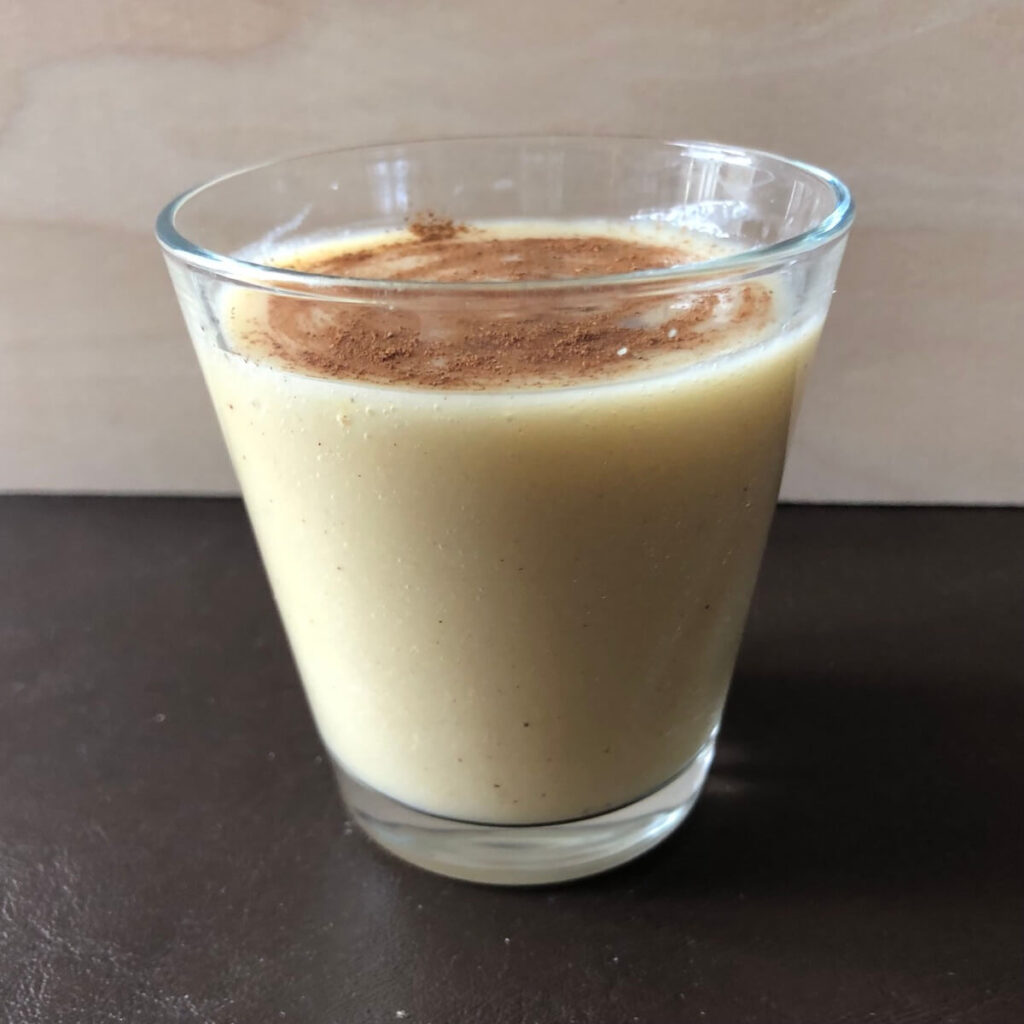
Why Make Chickpea Milk?
- Nutritious, plank based milk alternative
- Easy to make
- Unique milk, nutty flavour
- Rich in protein and fiber, and a great source of potassium
- Allergen friendly alternative that can be customized to your tastes
Pin It Now Later & Make It Later!
What Is Chickpea Milk?
Before diving into chickpea milk, let’s talk about chickpeas.
Chickpeas
Chickpeas, also known as garbanzo beans, are a staple in many households for their nutritional value and versatility.
I’ve discussed the benefits of heart health chickpeas on numerous occasions on the blog, and encourage consumption of chickpeas through hummus, Mediterranean chickpea quinoa bowl, and chocolate chickpeas.
Chickpeas offer plant protein and soluble fiber that lowers cholesterol. It is also a great source of iron, zinc, phosphorus, and B vitamins.
And guess what? Chickpeas are on the list of anti-inflammatory foods, list of low cholesterol foods, and part of a low cholesterol diet plan, They are also foods that lower blood pressure and unclog arteries. Need I say more?
So when I started noticing chickpea milk in the supermarket, and thought “hey, why don’t I try this myself” as another way to reap the benefits of chickpeas in my diet.
Chickpea Milk
Chickpea milk, also known garbanzo milk, is a type of plant-based milk made from chickpeas.
The neutral flavor profile of garbanzo bean milk is unique. It has a white color, and in terms of flavor it has a mild, slightly nutty taste. The texture is typically smooth and creamy. It is more robust in flavor than some other plant-based milks without a bitter taste which is sometimes found in almond or rice milk.
The taste can vary slightly based on the specific recipe used, with factors like the soaking time of the chickpeas, the ratio of water to chickpeas, and any added natural flavor influencing the final result.
Chickpea milk’s texture is one of its defining features. Thanks to the natural starches and proteins in chickpeas, it has a creaminess that closely mimics that of dairy milk, making it an excellent choice for those seeking a plant-based milk with a satisfying mouth feel.
It also provides great froth for your coffee, as a testament to its high protein. Just like aquafaba – the leftover liquid in a can of chickpeas has been used as a fluffy whipped egg replacer for the same reason!
In my experience as dietitian, I often only recommend soy milk as my plant based “milk” beverage of choice since oat, almond, or rice milk are low in protein. That’s why garbanzo bean milk has gotten me very excited as it is a great source or protein! Not to mention it’s low cost and it’s good for the environment.
Chickpea Milk Nutrition Facts
Are you ready to hear about chickpea milk nutrition facts? Chickpea milk is a nutrient-dense beverage that can contribute positively to a balanced diet, and specifically, it offers several nutrients that can support heart health. Overall, it has a good nutritional composition.
The nutrition in garbanzo bean milk will differ based on the brand and how is made. I have a chickpea milk recipe for you at the end of this post, and according to the nutrition facts of this recipe, 1 serving will provide:
- 14 grams of protein (wow!)
- 5 grams of fat (only 0.5 grams saturated fat)
- 36 mg of sodium
- 13 grams of fiber (double wow!!)
- 657 mg potassium (triple wow!!!)
- 91 mg of calcium
But the above nutritional information is only accurate if you don’t strain away any chickpeas. So just remember, the more chickpeas you strain away, the less nutrition the chickpea milk recipe will offer.
Protein Content
Continuing with the chickpea milk nutrition facts, chickpeas are a rich source of plant-based protein. The protein content in chickpea milk can vary depending on the specific recipe or product, but it is generally higher than that of many other plant-based milks.
A diet high in plant based protein is suggested in heart healthy diet patterns like the Mediterranean Diet, DASH diet, Portfolio diet, diet after a stent placement and the the MIND Diet.
This is because diets rich in plant-based proteins, as opposed to animal proteins, have been associated with lower risks of heart disease.
Chickpea protein contains essential amino acids and can support overall health in numerous ways. This includes promoting satiety, aiding in muscle repair and growth, and supporting metabolic functions (1).
Fiber Content
Chickpeas are also high in dietary fiber. Even though the process of making chickpea milk involves straining out solids, some fiber remains in the final product, especially if the milk is not excessively strained.
Dietary fiber is known to promote digestive health and help maintain stable blood sugar levels. From a heart health perspective, dietary fiber can help to lower levels of LDL (bad) cholesterol, which is a risk factor for heart disease.
Fat Content
Garbanzo bean milk is low in saturated fat (1)! This is important for my heart health clients as I am always recommending reducing saturated fat intake for optimal heart health to reduce risk of cardiovascular disease and prevent a heart attack and stroke.
Vitamin And Mineral Content
Chickpeas contain B vitamins, Zinc, magnesium, and iron which help with energy (1).
But more specifically from a heart health perspective I am blown away by the amount of potassium this dish has. Chickpeas contain a good amount of potassium, a vital mineral that aids in regulating fluid balance, muscle contractions, and nerve signals.
Potassium is essential for heart health as it can help lower blood pressure by counteracting the effects of sodium and easing tension in the blood vessel walls. While some potassium content may be lost in the process of making garbanzo bean milk, it still contributes a beneficial amount to your daily intake.
In summary, the chickpea milk nutrition facts reveal that it is a heart healthy beverage.

Health Implications
Read on to uncover the three major benefits of chickpea milk and its functional properties.
Cardiovascular Health
As I mentioned earlier, garbanzo milk is rich in protein, fiber, and potassium, all of which are beneficial for heart health. The high fiber content can help to reduce levels of LDL (bad) cholesterol, a key risk factor for heart disease.
Potassium helps to lower blood pressure by counteracting the effects of sodium and easing tension in blood vessel walls.
Moreover, the plant-based protein in chickpeas is associated with lower risks of heart disease compared to animal proteins. In addition to these nutrients, chickpeas also contain a type of antioxidant called polyphenols, which can protect against oxidative stress and inflammation, both of which are implicated in heart disease.
Digestive Health
Garbanzo bean milk can also be beneficial for digestive health, largely due to its fiber content. While the straining process in making chickpea milk removes some fiber, it still retains a beneficial amount.
Dietary fiber adds bulk to your diet and aids in regular bowel movements, thereby promoting overall digestive health. Furthermore, the fiber in chickpeas acts as a prebiotic, providing nourishment for beneficial gut bacteria, which play a crucial role in maintaining a healthy gut microbiome.
Bone Health
Chickpeas are a good source of calcium, a vital mineral for maintaining strong and healthy bones. While some of this calcium may be lost during the milk-making process, it can still contribute to your daily calcium intake.
Additionally, chickpeas contain other bone-healthy nutrients like magnesium and phosphorus, which play crucial roles in bone structure and strength.
Allergy And Dietary Considerations
Chickpea milk is not only tasty and refreshing but it is free from common allergens as it does not contain gluten, nuts, soy, and lactose.
Gluten-Free
Naturally gluten free since chickpeas do not contain gluten.
Nut-Free
Many plant-based milks, such as almond and cashew milk, are made from nuts, making them unsuitable for individuals with nut allergies. Garbanzo milk, on the other hand, is nut-free, offering a safe and nutritious alternative for those who need to avoid nuts.
Soy-Free
Naturally gluten free since chickpeas do not contain gluten.
Lactose-Free
Chickpea milk is naturally lactose-free, and thus a great alternative for those with lactose intolerance or for those choosing to follow a dairy-free diet.
Vegan
As a plant-based milk, chickpea milk is suitable for those following a vegan diet as it involves no animal products or byproducts.
Comparison To Other Alternative Milks
| Chickpea Milk | Soy Milk | Almond Milk | Oat Milk | |
| Nutritional Profile | High in protein and fiber, good source of potassium and other nutrients. | High in protein, fortified with vitamins and minerals. | Low in calories, protein, and fat, often fortified with vitamins and minerals. | High in fiber and B vitamins, often fortified with vitamins and minerals. Typically, low in protein. |
| Flavor Profile | Slightly nutty and creamy. | Mildly sweet and creamy. | Light and slightly nutty. | Sweet and creamy, like oatmeal. |
| Environmental Impact | Low impact, as chickpeas are legumes that enrich the soil with nitrogen. | Moderate impact, uses less water than almond milk but more than oat or chickpea milk. | High impact, requires a lot of water to grow almonds. | Low impact, oats grow in cooler climates and require less water. |
Table 1: Comparison to other non-dairy milks. Actual values may vary based on brand, region, and specific product formulation. For accurate nutritional information of plant-based milk alternatives, always refer to the product label.
Ingredients
As for the ingredients in the chickpea milk recipe, and as the name suggests, starts with chickpeas. You can use dried chickpeas, which need to be soaked overnight to soften, or canned chickpeas, which are pre-cooked and ready to use. Just be sure to rinse canned chickpeas thoroughly to remove any added salt or preservatives.
Water is the second essential ingredient, which when combined with the chickpeas, forms the bulk of the milk. The ratio of chickpeas to water can be adjusted based on your preference for thickness and creaminess.
Optional ingredients can be added to enhance the flavor of the milk. For a basic recipe, a dash of salt can help elevate the taste. For a sweeter milk, consider adding natural sweeteners such as dates, honey, monk fruit juice concentrate, or maple syrup. A touch of vanilla extract can add a pleasant aroma, and spices like cinnamon or nutmeg can lend warmth and complexity for optimized flavor.
How To Make Homemade Chickpea Milk Recipe
Step-By-Step Guide
Preparation Of Dried Chickpeas
Take three cups of dried whole chickpeas and place them in a large bowl or large container. Add in six cups of water, ensuring all chickpeas are fully submerged. Leave this mixture to soak overnight. The chickpeas will absorb the water and soften, preparing them for the next step.

Draining The Chickpeas
After the chickpeas have soaked overnight, drain the excess water from the bowl using a colander or mesh strainer. Discard the water and keep the hydrated chickpeas aside.
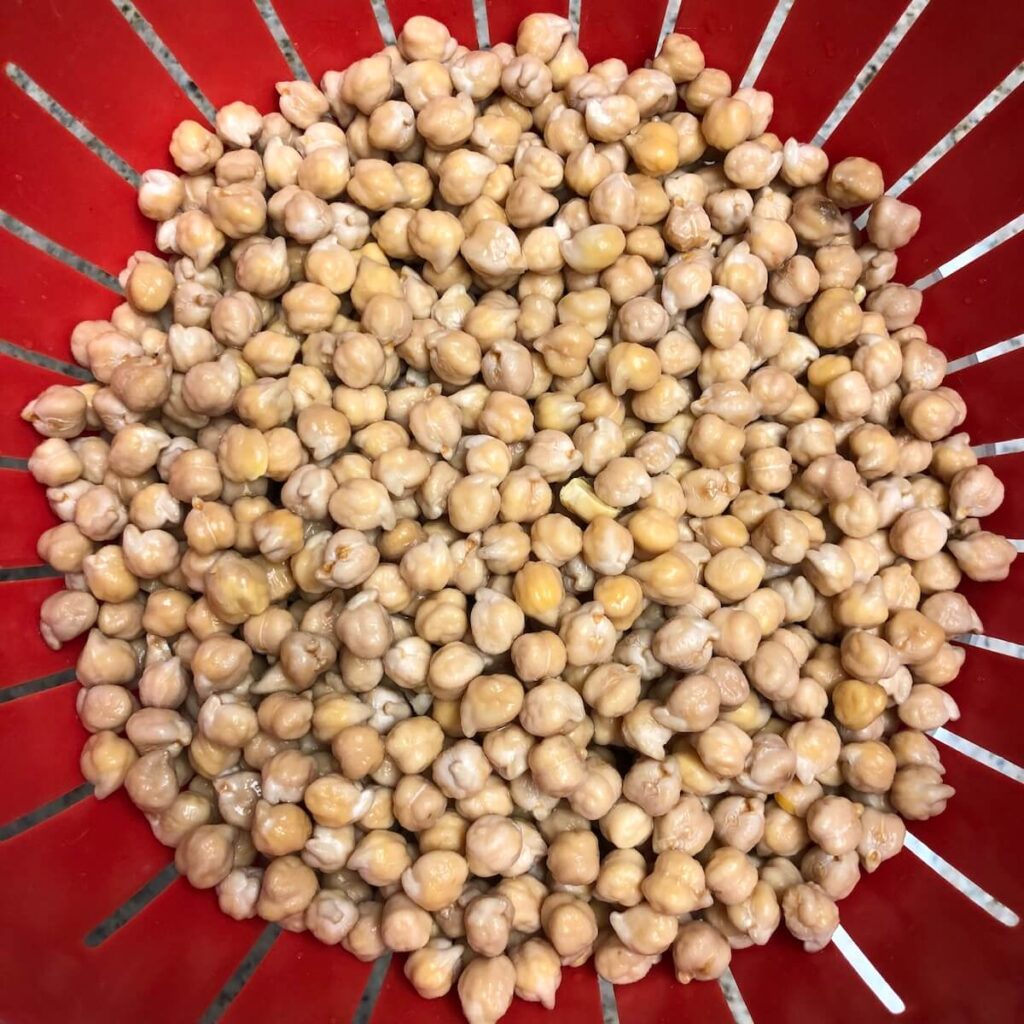
Creating Chickpea Paste
Place the drained chickpeas in a food processor. Start blending until the chickpeas are broken down. Gradually add in 250 mL of the total 2 L of filtered water you have set aside, continuing to blend until you achieve a smooth, thick paste. This blended chickpea forms the chickpea base.

Heating Water
Take a large pot and pour in the remaining 1.75 L of filtered water. Place this pot over high heat and bring the water to a boil.
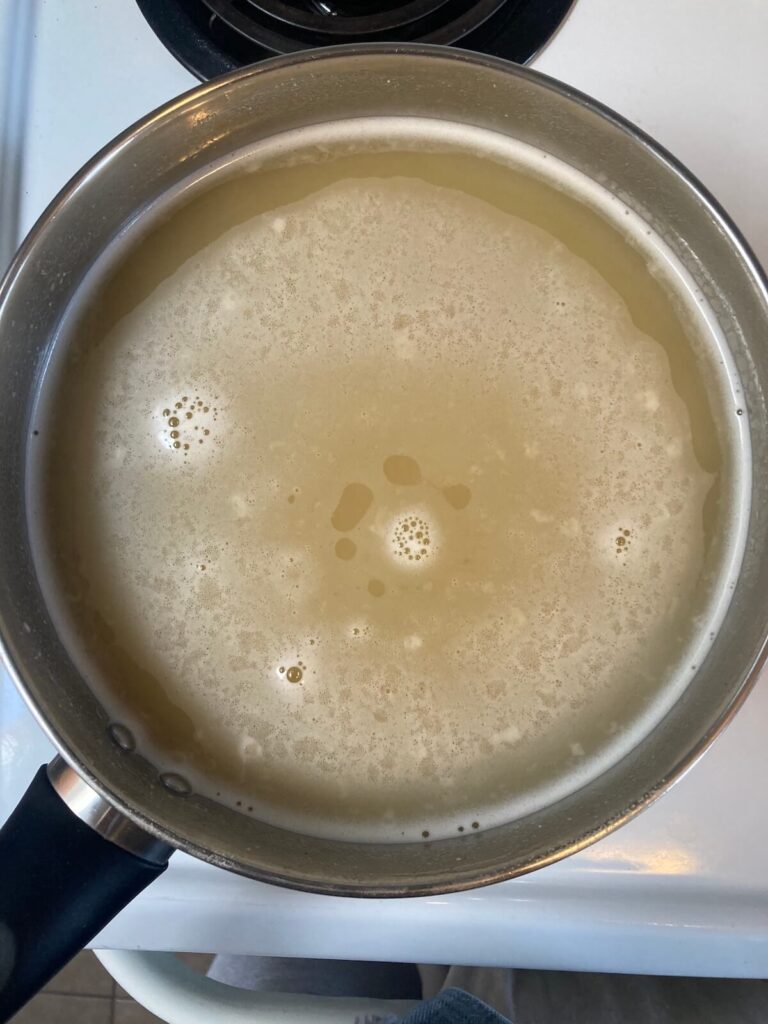
Adding Ingredients
Once the water is boiling, carefully add the chickpea paste to the pot. Also, add the aromatic ingredients – cinnamon, and a pinch of nutmeg, and nutrition ingredients if using like ground flaxseed. These will give your chickpea milk recipe a distinctive, flavorful profile.
Try not to overfill the pot here since garbanzo milk will create bubbles and may boil over.
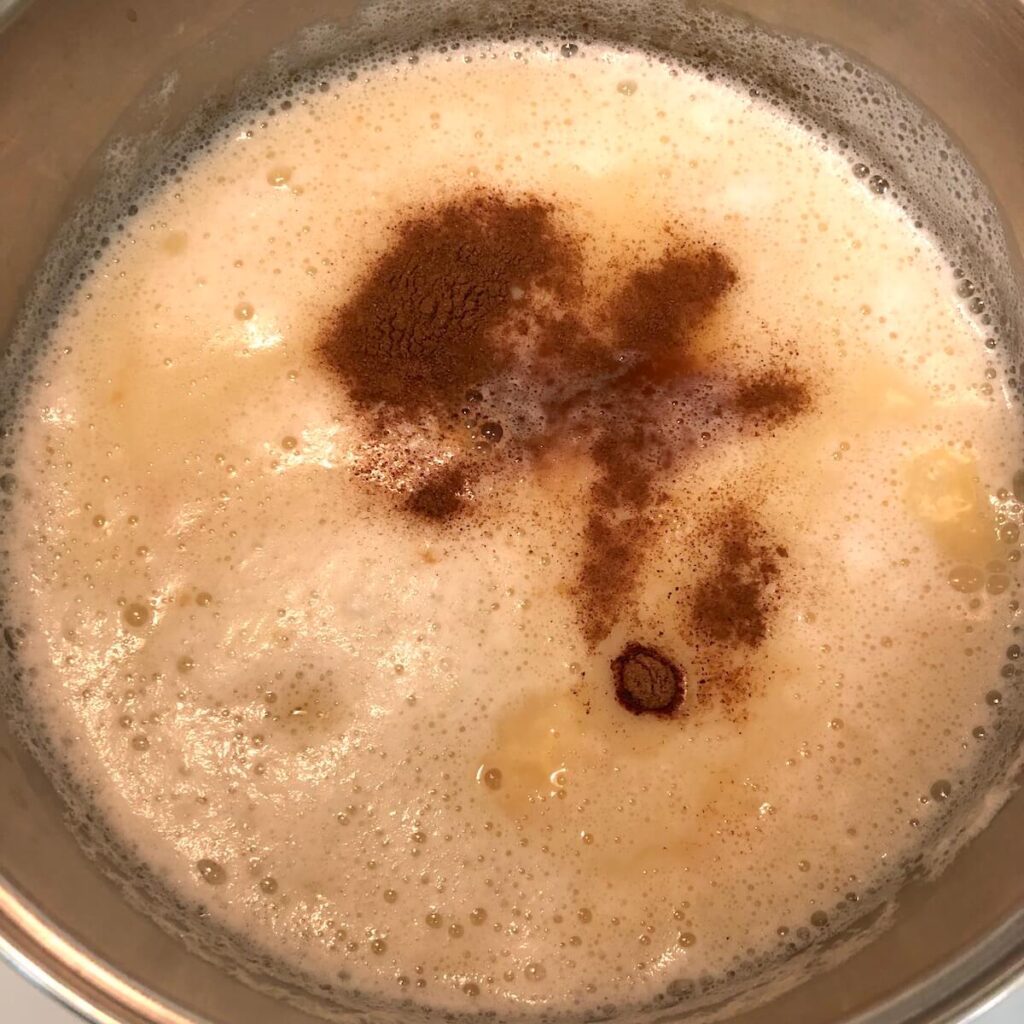
Mixing And Simmering
Stir everything thoroughly using a spatula, making sure to scrape the sides of the pot to fully incorporate any clinging paste. If the mixture seems too thick, feel free to gradually add more water until you reach your desired consistency. Lower the heat to medium-low, allowing the mixture to simmer for 30 minutes. This step will help the flavors meld together and the chickpeas to fully cook.
Sieving The Mixture
After the simmering process, take a large bowl and place a sieve over it. Carefully pour your chickpea mixture into the sieve. This will catch any remaining bits of chickpea, ensuring that your milk is smooth and clump-free.
Don’t throw out the remaining bits of chickpea you collected in the strainer or cheese cloth. Instead reduce food waste by adding this to smoothies which will also boost its nutritional content.
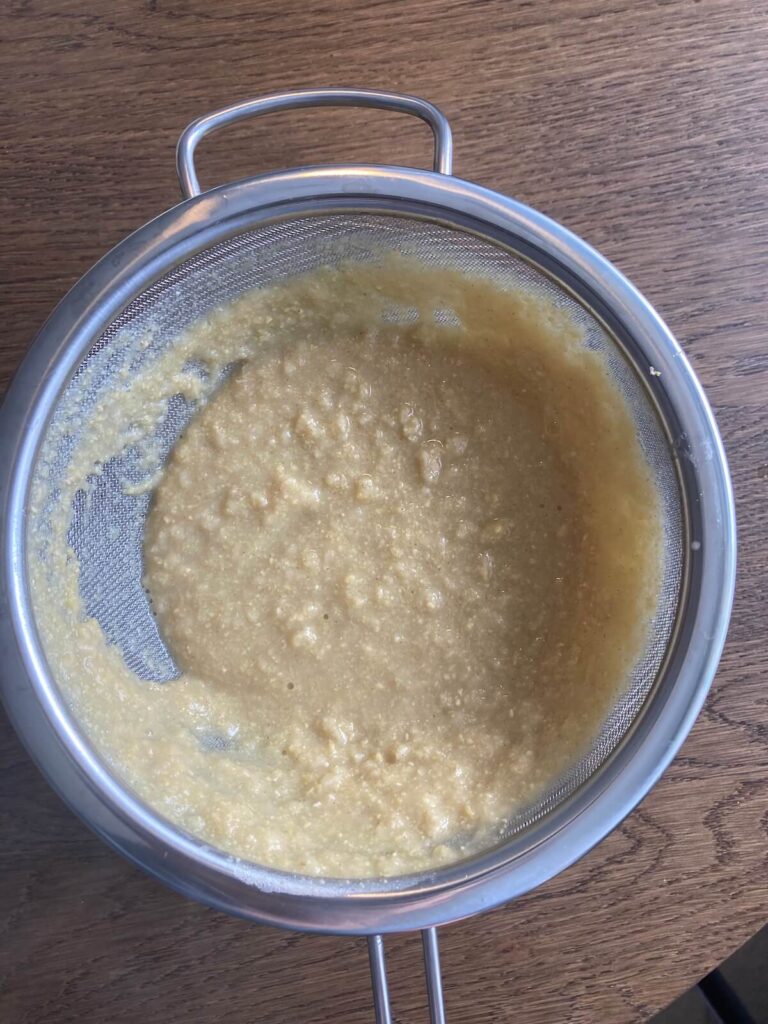
Serving The Chickpea Milk Recipe
Once the milk has been sieved, it’s ready to be served. Pour it into a cup or a glass jug for storage. Enjoy the chickpea milk (also known as chickpea water) warm or chill in the fridge for a refreshing cold beverage. Remember, homemade chickpea milk is a fresh product without preservatives, so it’s best consumed within a few days. Store it in the fridge in an airtight container (lasts 3-4 days in the fridge) or freeze it in a Ziplock bag (it should last around 3 months in the freezer).
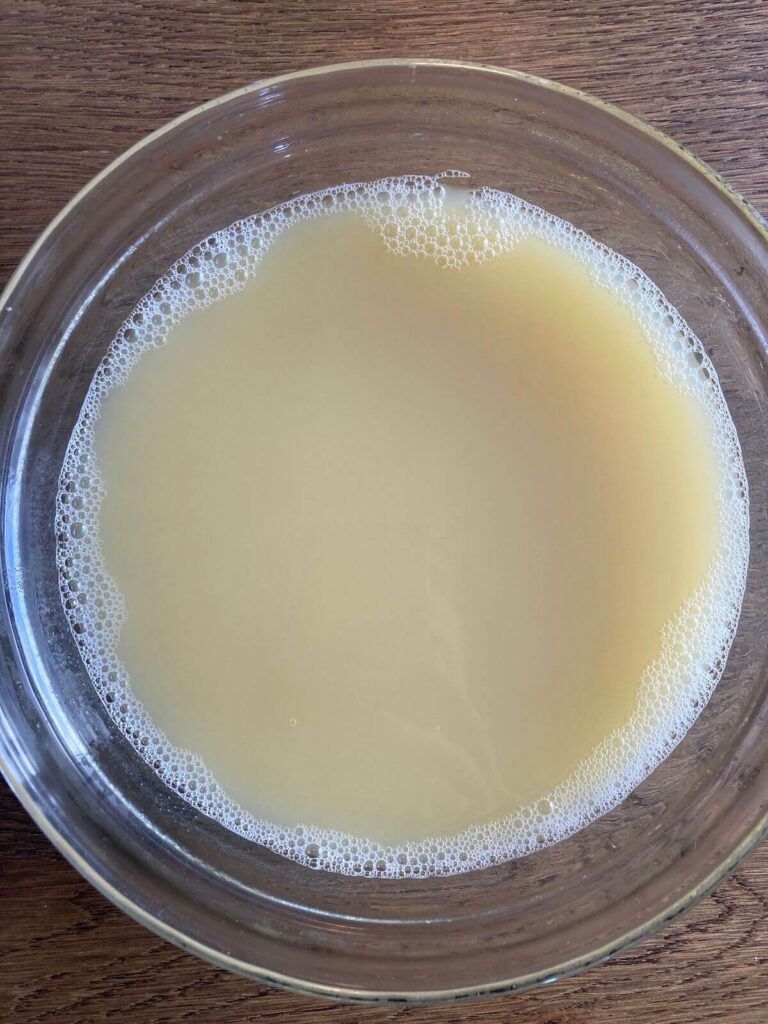
Necessary Tools And Ingredients
When preparing the homemade chickpea milk recipe, having the right tools can make the process a lot smoother. One of the most critical tools needed is a good-quality food processor or high-speed blender. This is used to blend the chickpeas into a paste, which forms the base for the milk. The more powerful the blender, the smoother your paste will be, leading to a more refined texture in your final product.
Find my favorite food processor here:

In addition to the blender, a large pot is needed for simmering the chickpea paste and water. The pot should be large enough to accommodate stirring and reduce the risk of the mixture boiling over.
Other tools needed include a sieve or cheese cloth for straining, a spatula for mixing, and a colander for draining the chickpeas. A large bow or jarl is also required for catching the strained milk.
My sieve of choice:

An example of cheese cloth

Or skip these tools and purchase the all in one Nut Milk Maker

Expert Tips For Achieving The Best Flavor And Consistency
Here are some tips to help you create a delicious and creamy chickpea milk:
Soak Chickpeas Properly
Soaking the dried chickpeas overnight or for at least 8 hours helps them soften, leading to a smoother blend. The water used for soaking should be discarded as it can have a strong, unpleasant taste. Using fresh water for blending will result in a cleaner flavor.
Blend Thoroughly
The key to a smooth consistency is blending the chickpeas thoroughly. A high-speed blender or food processor is excellent for this task. Blend until the mixture becomes a smooth, thick paste.
Simmer Slowly
When you’re cooking the chickpea paste in water, a slow and gentle simmer is beneficial. This allows the flavors to meld and develop fully. Rapid boiling may lead to a grainy texture.
Strain Well
Straining the mixture through a fine-mesh sieve or a nut milk bag ensures that your milk will be smooth and free of grit. You may want to strain the mixture twice for the best result.
Flavor Mindfully
Unflavored chickpea milk has a mild, slightly nutty taste that may be bland for some. Enhance the flavor by adding a pinch of sea salt, sweeteners like dates, honey, or maple syrup, or other flavorings like vanilla extract, cinnamon, or cocoa powder. However, be cautious with the quantities. You don’t want the additional flavors to overpower the natural taste of the chickpeas.
You can also add ground flaxseed, or top with chia seeds.
Chill Before Serving
Like most plant-based milks, chickpea milk often tastes best when chilled. After straining, allow the milk to cool down, then store it in the refrigerator in a clean glass container for a few hours before serving.
Store Properly
The homemade chickpea milk recipe should be stored in the fridge and consumed within a few days for the freshest taste. It’s also a good idea to shake or stir the milk before serving, as it can separate upon standing.
Video Tutorial
Watch how easily chickpea milk comes together!
How To Use Chickpea Milk
Chickpea milk has a promising future due to its nutritional advantages of high protein and affordability. It, like other plant-based milks, is versatile and can be used in a variety of dishes in the kitchen.
For example:
- consume it as a beverage, either cold or warmed up.
- use it in smoothies, adding creaminess and a nutritional boost
- Add it to coffee or tea
- try it with your breakfast dishes like cereals, porridge, overnight oats and granola
- it’s an excellent substitute for dairy milk in recipes for those who are vegan or have allergies
- can also use it in baking cakes, muffins, or bread
- or add it to your soups, sauces and curries
- coffee creamer to lower cholesterol
- add protein powder for a high protein chickpea milk
- add organic flax seed oil for more omega 3s
Frequently Asked Questions
Is Chickpea Milk Good For You?
Yes, chickpea milk is good for you. It’s a plant-based milk alternative that is high in protein and fiber, while being low in saturated fat. It also contains essential nutrients such as iron, magnesium, potassium, and vitamin B6. However, like any food product, its health benefits depend on how it’s prepared and consumed, and it should be part of a balanced diet.
What Does Chickpea Milk Taste Like?
Chickpea milk tastes mild and slightly nutty. It is more robust in flavor than some other plant-based milks, but not as strong as soy or oat milk. The texture is smooth and creamy. The taste can be enhanced by adding sweeteners or flavorings such as vanilla extract, cinnamon, or cocoa. The color is white.
Each brand of commercially made chickpea milk might taste slightly different depending on the specific recipe and process they use.
Do Chickpeas Have Milk?
No chickpeas themselves do not contain milk, but milk can be made from chickpeas, hence the term “chickpea milk”. This is a type of plant-based milk made by blending soaked chickpeas with water, then straining the mixture to remove any solid particles. The resulting liquid is a milky substance known as chickpea milk or chickpea water.
This process is similar to how other plant-based milks, such as almond or oat milk, are made. It’s important to note that chickpea milk doesn’t contain any dairy or animal products, making it a suitable choice for vegans and those with certain dietary restrictions.
Final Thoughts
Chickpea milk is an easy plant based dairy alternative that is, nutritious, and heart healthy.
Chickpea milk presents an excellent opportunity for those seeking a plant-based, allergen-friendly alternative to traditional dairy. It’s packed with essential nutrients, easy to make, and can be customized to suit your personal taste preferences.
I encourage you all to give chickpea milk a try. You might be surprised by how much you enjoy this humble legume transformed into a creamy, nourishing beverage. If you are looking for another homemade beverage, be sure to try oat water!
Lastly, I invite you to share your experiences with chickpea milk. Have you tried it before? Do you have a favorite recipe or a unique way of incorporating it into your meals? Perhaps you’ve tried different brands of commercially available chickpea milk and have some recommendations? I would love to hear your thoughts, feedback, and experiences, so please leave a comment below.
Recipe and photo by Isabelle Mah, Nutrition Student. Article was written by Veronica Rouse, MAN, RD, CDE.

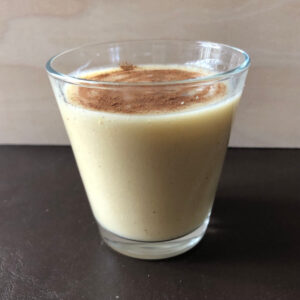
Chickpea Milk
Equipment
- 1 Food Processor
- 1 Large pot
- 1 Sieve or cheese cloth
- 1 Large Bowl
Ingredients
- 3 cups dried chickpeas
- 6 cups water for soaking chickpeas
- 2 L water filtered
- 1 tbsp cinnamon
- 1/2 tsp nutmeg
- 1 tbsp vanilla extract
Instructions
- Soak 3 cups of dried chickpeas overnight in a large bowl
- Drain water from chickpeas
- In a food processor, pour in the chickpeas and blend until smooth.
- While blending, slowly add 250 mL of the 2 L of filtered water to form a paste.
- In a large pot, pour in the rest of the filtered water and bring to a boil.
- Add in the chickpea paste, vanilla extract, cinnamon, and nutmeg.
- Mix thoroughly and use a spatula to scrape the dies of the pot and break up clumps. Feel free to add more water to achieve desired consistency.
- Adjust to heat to medium-low and let simmer for 30 minutes.
- Using a large mixing bowl, use a sieve and pour the chickpea mixture through it to catch bits of chickpea. The milk will be smooth once sieved.
- Pour into a cup and enjoy!

Do you have any ideas on how to use the remaining chickpea meal? I hate to toss it! I’ve made my own almond milk before and used the leftover almond meal in recipes that call for almond meal. Thanks!
Great question Joanne! I would add it to soups or smoothies!
Why does it read 3 cups dried which I did then the actual recipe says 2 cups soaked chickpeas? Which is it? Thank you.
Sorry, it should say 3 cups soaked chickpeas. I will change that, thanks for letting me know!
Veronica